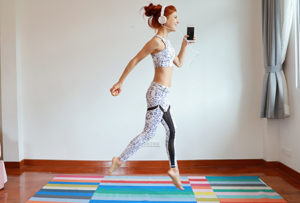Best Classical Music to Workout to Even When You Are at Home

© Twenty20
Recently I read that an enthusiastic chap completed a marathon run inside his apartment. That’s right, unable to train in the outside world because of the Covid-19 lockdown, he simply kept running circles around his couch. I wonder what his downstairs neighbors thought of all that running around upstairs? “Mens sana in corpore sano” (a healthy mind in a healthy body) as the old Romans used to say. It basically expresses the theory that physical exercise is an important if not essential part of mental and psychological wellbeing. Whether you believe this saying or not, in trying times like today, it is important to leave the couch behind and maintain physical fitness. Since all the gyms have closed, it’s time to start a proper work out routine at home. Although we can’t tell you what exercises might best fit your level of fitness and motivation, we can provide you with the best classical music to make your workout go more smoothly. Time to get that blood flowing, and that includes a little warm-up stretching with Rossini.
Gioachino Rossini: Guillaume Tell Overture (London Philharmonic Orchestra; Arturo Leonard, cond.)
Now that you are all warmed up, it’s important that you don’t push your pulse rate into the red danger area of your Pulse Oximeter. And I think a little steady Seb Bach might do the trick. When he was sacked by Prince Leopold, Bach decided to sent Christian Ludwig, the Margrave of Brandenburg, a collection of six instrumental compositions. Today we know them as the Brandenburg Concertos, but no matter the quality of the music, Bach did not get the job.
Johann Sebastian Bach: Brandenburg Concerto No. 4 in G Major, BWV 1049 – I. Allegro (Prague Chamber Soloists; Andrew Mogrelia, cond.)
For me personally, one of the most frustrating aspects of working out at home or at the gym is the fact that while physically moving, I still don’t get anywhere! I guess growing up surrounded by the Austrian Alps, a work-out with a view was part of my daily fitness program. And that’s exactly how Richard Strauss must have felt when he wrote his large tone poem An Alpine Symphony. It reminded him of an adventure as a boy, when he and a group of climbers lost their way heading up a mountain and were caught in a storm and soaked on the way down. Come to think of it, there are certain advantages for working out indoors while listening to classical music.
Richard Strauss: An Alpine Symphony
It’s time to turn up the intensity a bit with John Adams’ Roadrunner. Originally the composer intended to write a children’s piece, but concurrently he was studying the score of Schoenberg’s Chamber Symphony. In the next room, his son was watching cartoons. “The hyperactive, aggressive and acrobatic scores for the cartoon mixed in my head with Schoenberg’s music, and I realized suddenly how much these two traditions had in common.”
John Adams: Chamber Symphony – III. Roadrunner (Alarm Will Sound; Alan Pierson, cond.)

© www.techradar.com
It’s time to take it a little easier and start the warm-down phase of your workout. Wolfgang Amadeus Mozart composed a total of twenty-three string quartets, and some of the most innovative pieces in this genre are dedicated to Franz Joseph Haydn. His String Quartet No. 17 was composed in 1784 and over time has acquired the nickname “The Hunt.” It apparently references the stylized hunting-calls that open the work. Unfolding in a lively and lilting 6/8, the opening “Allegro” strings together a variety of delightful melodies and themes that provide uncomplicated and unadulterated exercise pleasure.
Wolfgang Amadeus Mozart: String Quartet No. 17, K. 458, “Hunt” – I. Allegro vivace assai (Armida Quartet)
Let’s give this musical workout one more hardy push. How about the last movement from Rachmaninoff’s third piano concerto? It’s one of the longest, most ambitious and most notoriously difficult works for piano and orchestra. In the great tradition of the Russian novel, this concerto is a very long story full of every kind of emotion. Perfect classical music for a workout at home, don’t you think?
Sergei Rachmaninoff: Piano Concerto No. 3 in D Minor, Op. 30 – III. Finale: Alla breve (Yuja Wang, piano; Simón Bolívar Symphony Orchestra of Venezuela; Gustavo Dudamel, cond.)
If you think that fast-past dance music and techno is the most beneficial backdrop for working out, you would be incorrect. Actually, studies suggest that classical music produces the best result. While most music helps to motivate people to work out harder and longer, upbeat classical music not only increases your speed, strength and endurance, it also reduces heart rate, blood pressure and lower perceived exertion. Let’s finish our workout with a flurry from Beethoven’s 4th Symphony. Stay healthy in body and spirit with the best classical music to workout to!
For more of the best in classical music, sign up to our E-Newsletter
Ludwig van Beethoven: Symphony No. 4, Op. 60 – IV. Allegro ma non troppo (Bavarian State Orchestra; Carlos Kleiber, cond.)
